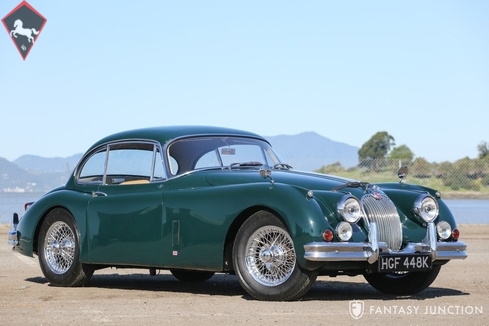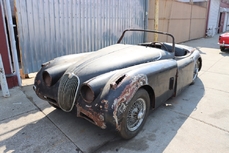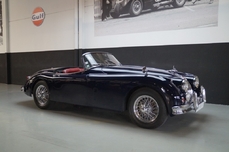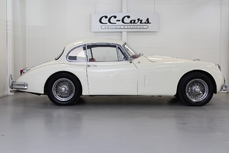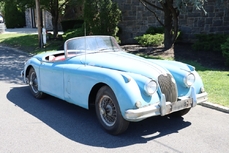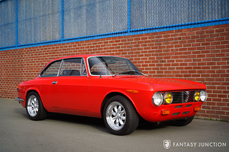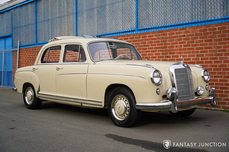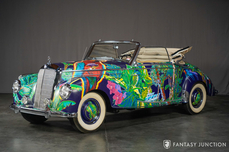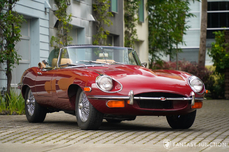Jaguar XK150 3.8 Liter Inline-6 1958
General description :
1958 Jaguar XK150 Fixed Head Coupe
s/n S 834796, engine no. R9042-9
British Racing Green with Biscuit Leather
The stunning XK120 put Jaguar on the map as one of the premier manufacturers of modern sports cars. The motoring public and press raved over the performance, presence, and value of these beautiful cars. As years evolved, revisions and improvements refined these cars into some of the finest sports cars available. The XK150 would become the final evolution of the much-lauded XK line, capping more than a decade of production that included five Le Mans wins, design awards, global sales success, and continuous media accolades. The XK150 featured an all-new and wider body, offering greater interior room, blended front and rear fenders and smoother body surfacing. Performance was enhanced with a variety of hotter engine options culminating with the triple carbureted 3.8 liter version. The XK150 not only offered performance excellence, the interior was offered with just the right amount of elegance to make it a refined road car.
In addition to the many improvements featured on the XK150, a smooth, one-piece wrap around windscreen, accented by a curvaceous side glass opening, delivered expansive visibility from the cockpit. The exterior was devoid of excess chrome other than the grille and fascia treatments and required bumpers. The clean and pure Fixed Head Coupe configuration was the perfect performance profile for anyone wanting a touring car with both refinement and a sporting nature. By 1958, disc brakes were added to the lineup and performance options including a higher horsepower “S” model, designated by a chrome plated S at the exterior forward corner of the doors.
According to records supplied by the current and previous owners, this handsome XK150 coupe was manufactured November 21, 1957, leaving the factory as a 3.4 litre powered car with engine number V 2132-8. Finished in Cream with red interior, the car was dispatched to Jaguar Cars, New York, NY on December 9, 1957 and first sold in January 1958. The car made its way to California relatively early in its life and still wears its black license plates dating from the late 1960s. Documents dating as far back as 1975 also support the car’s long-term California history. In 2006, the previous owner purchased the car as a restoration project, having been stored since 1991. Photos of the car at time of purchase show it as a largely original example still in its original cream on red color combination, sitting on chrome wire wheels and equipped with wood-rimmed Nardi steering wheel.
Beginning in 2006, under previous ownership, the car was treated to a comprehensive five-year restoration with the goal of making it a performance-based touring car that would deliver improved performance and reliability while leaving the fundamental character of the car intact. The car was disassembled, and all panels prepared for new paint. Having been in California, the frame and body panels were not subject to harsh conditions and were very sound prior to the restoration. The green paint was professionally applied, and chrome plating redone throughout the car. A 3.8 litre engine was selected, and rebuilt using an upgraded vibration dampener, higher compression ratio, and slightly more aggressive cams. The engine was outfitted with triple Weber carburetors and a specially cast intake manifold sourced from Pierce Manifolds was installed. The completed engine was mated to a new Classic Jaguar 5-speed transmission. As part of the build, a billet aluminum adapter plate was installed using Grade 8 fasteners, new CJ5 driveshaft, new CJ5 speedometer cable and drive gear, heavy duty 10” CJ5 clutch disc, polished billet scatter shield, and billet 5-speed gearshift knob. Jaguar trim specialists at BAS LTD supplied interior materials, reupholstered specific components in Biscuit leather and further finishing was performed including a new fawn headliner and new carpet. Upon completion, the car was trimmed with the distinctive “S” emblem on the upper door, signifying the performance theme of the original, with a nod to the modern upgrades.
Among the many features that were improved while the car was restored and upgraded to the new specifications, the owner installed 1/2” wider wire wheels, a new more efficient radiator with an electric cooling fan, an upgraded C-45 starter motor (itself a $1,000 expense), a new alternator (installed inside an original generator casing), polarity was switched to negative ground, stainless steel exhaust and headers installed, and a custom hidden sound system installed in the interior and trunk. In June 2019, the current owner performed a compression check confirming all cylinders at 170-180lbs. The Weber carburetors were removed and rebuilt, new fuel hose installed, a new fuel pump installed, coil wire replaced, a vacuum leak repaired, and the oil and filter changed. During the test drive after work was performed, mid-range throttle response was not ideal. New larger idle jets were installed, carbs reset, and ignition timing set to 38 degrees. The results have improved performance and throttle response. During this same period, the front wheels were removed and professionally balanced.
Today, this handsome XK150 presents in very good condition, having been enjoyably used over the years and properly maintained. The paint still retains a high gloss finish overall with some road use evident in the front area, some light swirl marks and other surface imperfections, and a few minor scuffs when viewed closely. Underneath the driver’s side S emblem there is some paint chipping and a few other areas showing minor chips particularly in the closure gaps. The panel fit is good throughout with very nice fit to the doors and trunk. The doors, hood, and trunk all open and shut with excellent fit and closure, with an homage to racing in the form of a leather strap across the forward hood section. The grill, trim, and window garnish molding are in excellent visual condition with no major scuffs or scratches, though the bumpers have some light hazing evident in some of the top surfaces. The lighting and lenses are beautifully finished. The car wears a set of chrome plated wire wheels showing no cub rash and excellent plating throughout. The car is shod with slightly wider Vredestein Sprint Classic tires with excellent tread remaining.
The interior leather surfaces are in excellent condition with no significant signs of wear on the seats or door panels, tight piping lines, and good seat support. The quality of the workmanship is generally excellent. Carpet is in good condition overall with minor edge wear at the doorsill trim and some light evidence of use in the driver’s foot-well and passenger area. The dashboard and surrounding door trim are beautifully finished with excellent fit to the leather and correct installation. The instruments in particular have been correctly restored still showing vivid color to the dial faces and very nice bright-work trim accenting the dashboard and instruments. The steering wheel is a handsomely finished wood rimmed accented with polished aluminum spokes and Jaguar horn button. Behind the seats, the rear compartment has been properly finished with correct materials and appears to have been only minimally used since the restoration was completed. In addition to the cohesive nature of the interior, the floor-shift 5-speed is perfectly integrated into the interior. Overall the interior is in excellent condition, showing just minor signs of thoughtful use since the restoration was completed, but notably still featuring beautiful chrome details including the delicate window hand levers, door handles, various trim, and the cleverly concealed modern radio tucked inside the driver’s side dashboard glove pocket. The trunk compartment is carpeted in matching interior material, housing the stereo unit, full sized tire and wire wheel as well as tools and jacking equipment.
The engine compartment is beautifully finished with proper polishing on the factory aluminum castings, correct gloss finishes on assorted black parts, and correct finishing on the inner fenders and firewall. While some time has passed since the restoration was completed and a few of the components have warmed a bit and lightly mellowed in finish, the evidence of excellence clearly shows in the finishes, correct fasteners, and attention to originality. Viewing the underside of the car, one clearly can see the attention to detail afforded during the restoration process as the underside is very nicely presented. And while there is evidence of road use, there are no visible signs of structural compromise, supporting the long-term California history and indicting appropriate care properly afforded by current and previous owners.
With a flip of key and just a moment’s pause for priming the Webers, the engine starts easily at the push of the starter button. Engine idle is smooth as operating temperature comes up, with good throttle response and oil pressure. The clutch engages easily as the car sets off smoothly and briskly as one might expect from enlarged 3.8 liter engine with triple Webers. The carburetors operate very well in the mid to upper revs as the car pulls hard on acceleration and the slightly hotter cams come on. Coupled with the well-judged ratios in the 5-speed gearbox, the car is genuinely swift and sounds superb, thanks especially to the velocity stacks. The gearchange has a modern mechanical, slick feel, with excellent synchromesh and a nice tall 5th gear for cruising at speed. This, coupled with the fixed head composure and confident disc brakes, delivers confidence with every mile. Braking is smooth and in keeping with technology of the period while road manners at highway speeds or leisurely cruising are particularly satisfying. The car comes with a tool roll and tools, correct jack, and mallet, an original owner’s manual, and selected ownership documents.
This handsome and wonderfully updated Jaguar XK150 Fixed Head Coupe embodies all the desirable advances of the original design, coupled with well-sorted and preferred performance mechanicals. Outfitted with disc brakes and Weber carburetion and ready for enjoyable driving, this XK150 is at home touring quaint roadways or open highways or in attendance at local shows and Jaguar club gatherings. This uniquely prepared XK150 will delight the next fortunate owner with elegant motoring pleasure and charm that only a vintage Jaguar can deliver.
https://fantasyjunction.com/inventory/1958-jaguar-xk150-fixed-head-coupe/overview
1958 Jaguar XK150 3.8 Liter Inline-6 is listed sold on ClassicDigest in Emeryville by Fantasy Junction for $75000.
Car Facts
Car type : Car Make : Jaguar Model : XK150 Model Version : 3.8 Liter Inline-6 Engine size : 3.8 Model Year : 1958 Location : Emeryville Vehicle Registration : Normal
Sold
Seller Information
Sold
People who viewed this Jaguar XK150 also viewed similar Jaguar listed at ClassicDigest
Other cars listed for sale by this dealer
About Jaguar
Ah, the story of Jaguar, from its early days as the SS Cars Ltd. to its pinnacle with the D-type, and the street-going evolution in the form of the iconic E-type. There's something quintessentially British about this tale, and I'll narrate it as a British journalist might.In the Beginnings:
Our journey into the world of Jaguar begins in the 1930s, when a company known as SS Cars Ltd. emerged. Despite the unfortunate coincidence of their initials with the rising political tensions in Europe, they started producing stylish and performance-oriented cars. The SS 100, introduced in 1936, was a symbol of elegance and speed, setting the stage for what would become Jaguar.
The Birth of Jaguar:
As the shadows of World War II loomed, SS Cars Ltd. wisely decided to disassociate themselves from the SS initials. Thus, in 1945, they officially became Jaguar Cars Ltd., a name that would soon be synonymous with British luxury and performance.
The XK Series:
Jaguar's post-war era brought us the XK 120, a true sensation in 1948. With its sleek design and a powerful 3.4-liter inline-six engine, it became the world's fastest production car. The XK 120 was the blueprint for what lay ahead – Jaguars that blended style with speed in a uniquely British fashion.
The D-type Dominance:
Then came the D-type, a true racing legend. Introduced in 1954, it won Le Mans three times in the 1950s, showcasing Jaguar's engineering prowess. With its innovative monocoque construction and the iconic fin at the back, the D-type was the apex of Jaguar's motorsport success.
The E-type Emergence:
But the true turning point arrived in 1961 with the introduction of the E-type, often described by Enzo Ferrari as "the most beautiful car ever made." Its long bonnet, curvaceous body, and a 3.8-liter engine delivering exhilarating performance made it an instant classic. The E-type was not just a car; it was a work of art on wheels, and it could hit 150 mph on the road.
Street and Racing Success:
The E-type's beauty was matched by its capability on the track. The lightweight E-types were particularly successful in various racing events, cementing Jaguar's reputation as a force to be reckoned with in motorsport.
The Age of Refinement:
As we delve deeper into the Jaguar story, we find that the 1950s and 1960s were an age of refinement and expansion. Alongside the magnificent D-type and the E-type's iconic emergence, Jaguar introduced models that further solidified its reputation for luxury and performance.
The MK2:
In the late 1950s, Jaguar unveiled the MK2, a sports sedan that combined elegance with power. This sleek four-door saloon was a favorite of bank robbers and law enforcement alike, thanks to its exceptional speed and handling. The MK2 was a symbol of Jaguar's ability to blend sophistication with performance and had a successful racing career as well.
The XJ6:
Fast forward to 1968, and Jaguar launched a car that would define luxury saloons for decades to come – the XJ6. It was a masterpiece of engineering and design, featuring a smooth inline-six engine, independent rear suspension, and a spacious, beautifully appointed interior. The XJ6 was a symbol of British elegance and provided a ride so smooth that it seemed to glide over the road. It became the flagship model for Jaguar and set the standard for luxury saloons, showcasing a level of refinement that left competitors in awe.
The Blend of Classic and Modern:
While the MK2 and XJ6 represented the evolution of Jaguar's saloon cars, they maintained the brand's commitment to performance and luxury. These cars didn't just belong on the racetrack; they were equally at home cruising down the grand boulevards or gliding through the English countryside.
The Challenges of Change:
However, as the 1970s arrived, Jaguar, like many British automakers, faced financial challenges and changes in ownership. The British Leyland era brought both opportunities and struggles, as the brand navigated through various mergers and transitions.
Nevertheless, the legacy of the MK2 and XJ6, along with the D-type and E-type, continues to define Jaguar as a manufacturer that combines timeless elegance with a spirit of performance. These classic models, whether driven on winding roads or parked as collectors' treasures, serve as a testament to Jaguar's enduring presence in the world of automotive excellence.
The Jaguar story, from its early days as SS Cars Ltd. to the creation of automotive icons like the E-type, MK2, and XJ6, is a journey that reflects the very essence of British motoring – a blend of luxury, power, and style that continues to captivate enthusiasts and connoisseurs alike.
